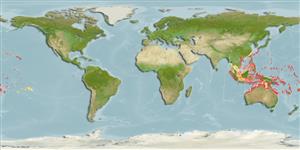>
Eupercaria/misc (Various families in series Eupercaria) >
Scaridae (Parrotfishes) > Scarinae
Etymology: Hipposcarus: Greek, ippos = horse + Latin, scarus = a fish cited by ancient writers; 1601 (Ref. 45335).
More on author: Valenciennes.
Environment: milieu / climate zone / depth range / distribution range
Sinh thái học
Biển Cùng sống ở rạn san hô; Mức độ sâu 0 - 40 m (Ref. 37816). Tropical; 30°N - 24°S, 95°E - 141°W
Pacific Ocean: Cocos-Keeling Islands and Rowley Shoals in the eastern Indian Ocean to the Line and Tuamoto islands, north to the Ryukyu Islands, south to the Great Barrier Reef and New Caledonia. Replaced by Hipposcarus harid in the Indian Ocean.
Bộ gần gũi / Khối lượng (Trọng lượng) / Age
Maturity: Lm ? range ? - ? cm
Max length : 60.0 cm TL con đực/không giới tính; (Ref. 9710); common length : 48.0 cm SL con đực/không giới tính; (Ref. 37816)
Các tia vây lưng cứng (tổng cộng): 9; Các vây lưng mềm (tổng cộng): 10; Tia cứng vây hậu môn 3; Tia mềm vây hậu môn: 9. Small juveniles are light brownish with a broad longitudinal orange band; the primary phase is a whitish brown to light gray with a yellowish tail; the terminal phase is light blue and green (Ref. 1602, 48636). Adults best recognized by the shape of the head (Ref. 48636).
Inhabits turbid lagoons more than outer reef areas. Usually seen in aggregations; females usually in small groups (Ref. 48636). Feeds on benthic algae (Ref. 89972). Minimum depth reported taken from Ref. 128797. Large adults may occur to depths of at least 40 m.
Life cycle and mating behavior
Chín muồi sinh dục | Sự tái sinh sản | Đẻ trứng | Các trứng | Sự sinh sản | Ấu trùng
Oviparous, distinct pairing during breeding (Ref. 205).
Randall, J.E., G.R. Allen and R.C. Steene, 1990. Fishes of the Great Barrier Reef and Coral Sea. University of Hawaii Press, Honolulu, Hawaii. 506 p. (Ref. 2334)
IUCN Red List Status (Ref. 130435)
Threat to humans
Reports of ciguatera poisoning (Ref. 130160)
Human uses
Các nghề cá: Tính thương mại
Thêm thông tin
Các tài liệu tham khảoNuôi trồng thủy sảnTổng quan nuôi trồng thủy sảnCác giốngDi truyềnElectrophoresesDi sảnCác bệnhChế biếnNutrientsMass conversion
Các công cụ
Special reports
Download XML
Các nguồn internet
Estimates based on models
Preferred temperature (Ref.
123201): 24.8 - 28.9, mean 27.7 °C (based on 518 cells).
Phylogenetic diversity index (Ref.
82804): PD
50 = 0.7500 [Uniqueness, from 0.5 = low to 2.0 = high].
Bayesian length-weight: a=0.01175 (0.00722 - 0.01913), b=3.02 (2.88 - 3.16), in cm total length, based on LWR estimates for this species & (Sub)family-body (Ref.
93245).
Mức dinh dưỡng (Ref.
69278): 2.0 ±0.1 se; based on diet studies.
Thích nghi nhanh (Ref.
120179): Chiêù cao, thời gian nhân đôi của chủng quần tối thiểu là dưới 15 tháng (K=0.5).
Fishing Vulnerability (Ref.
59153): Low to moderate vulnerability (27 of 100).
Nutrients (Ref.
124155): Calcium = 43.9 [25.2, 80.3] mg/100g; Iron = 0.713 [0.385, 1.197] mg/100g; Protein = 18.8 [16.7, 20.6] %; Omega3 = 0.0999 [, ] g/100g; Selenium = 42.2 [24.0, 80.9] μg/100g; VitaminA = 30.4 [9.0, 104.6] μg/100g; Zinc = 1.44 [0.99, 2.25] mg/100g (wet weight);
